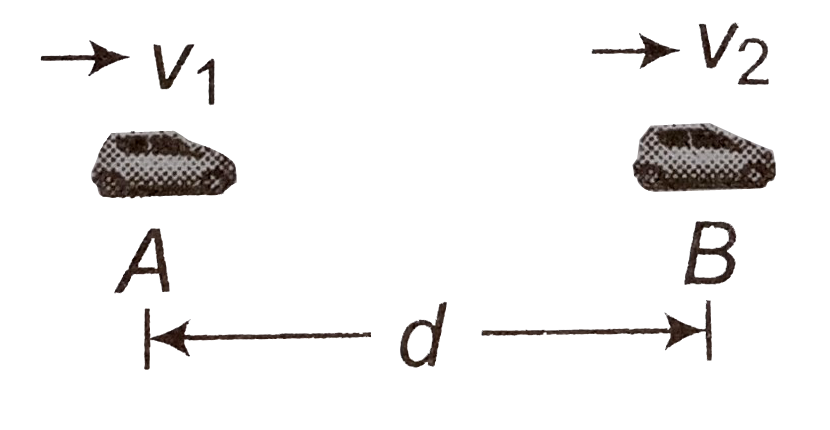Two car A and B travelling in the same direction with velocities v1 and v2(v1>v2). When the car A is at a distance d ahead of the car B, the driver of the car A applied the brake producing a uniform retardation a. There wil be no collision when.
d<(v1−v2)22a
d<(v21−v22)2a
d>(v1−v2)22a
d>(v21−v22)2a
The correct Answer is:C

vA/B=(v1−v2)
Let car A stop after traveling a distance s.
0=(vA/B)2−2as
s=(v1−v2)22a
For no collision, s>d
(v1−v2)22a<d or d>(v1−v2)22a
Topper's Solved these Questions
Similar Questions
Two cars, A and B, are traveling in the same direction with velocities va and vb respectively. When car is at a distance d behind car B, the brakes on A are applied, causing a deceleration at a rate a. Show that to prevent a collision between A and B it is necessary that:
View SolutionA car takes 25 s to stop after the application of brakes. What is the distance traveled by the car if the brakes produce a uniform retardation of 0.4 m s−2?
View Solution
Knowledge Check
- Question 1 - Select One
Two cars A and B are travelling in the same direction with velocities v1 and v2(v1>v2). When the car A is at a distance d ahead of the car B, the driver of the car A applied the brake producing a uniform retardation a. There will be no collision when
Ad<(v1−v2)22aBd<v21−v222aCd>(v1−v2)22aDd>v21−v222a - Question 2 - Select One
Two cars A and B are moving in same direction with velocities 30 m/s and 20 m/s. When car A is at a distance d behind the car B, the driver of the car A applies brakes producing uniform retardation of 2m/s2. There will be no collision when :-
Ad<2.5mBd<125mCd>25mDd>125m - Question 3 - Select One
What happens to the speed of a moving car when force is applied in the opposite
ASpeed increasesBSpeed decreasesCNo change in speedDChange in direction
Two cars 1 and 2 move with velocities v1 and v2, respectively, on a straight road in same direction When the crs are separated by a destance d the driver of car 1 applies brakes and the car moves with uniform retardation a1, Simultaneously, car 2 starts accelerating with a2, If v1<v2, find the minimum initial separation between the cars to avoid collision between then.
View SolutionThe driver of a train moving at a speed v1 sights another train at a disane d, ahead of him moving in the same direction with a shower speed v2. He applies the brakes and gives a constant teradation a to his train. Show that here will be no collision if d>(v1−v2)2/2a.
View SolutionA car is moving with speed u. Driver of the car sees red traffic light. His reaction time is t, then find out the distance travelled by the car after the instant when the driver decided to apply brakes. Assume uniform retardation 'a' after applying brakes.
View SolutionTwo cars 1 & 2 starting from rest are moving with speeds V1 and V2m/s(V1>V2). Car 2 is ahead of car 1 by a meter when the driver of the car 1 sees car 2 what minimum retardation should be given to car 1 to avoid collision.
View SolutionWhen the driver of a fast moving car suddenly applies brakes, the passengers in the car
View Solution

